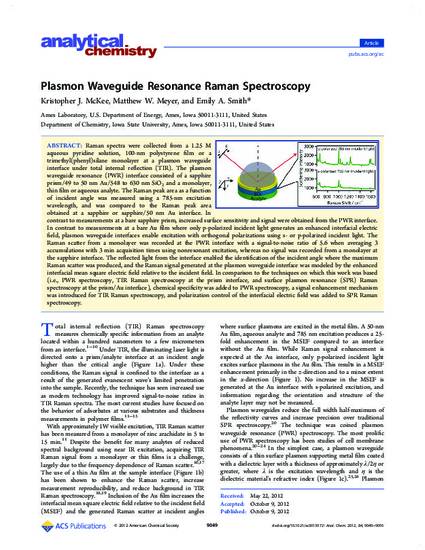
Raman spectra were collected from a 1.25 M aqueous pyridine solution, 100-nm polystyrene film or a trimethyl(phenyl)silane monolayer at a plasmon waveguide interface under total internal reflection (TIR). The plasmon waveguide resonance (PWR) interface consisted of a sapphire prism/49 to 50 nm Au/548 to 630 nm SiO2 and a monolayer, thin film or aqueous analyte. The Raman peak area as a function of incident angle was measured using a 785-nm excitation wavelength, and was compared to the Raman peak area obtained at a sapphire or sapphire/50 nm Au interface. In contrast to measurements at a bare sapphire prism, increased surface sensitivity and signal were obtained from the PWR interface. In contrast to measurements at a bare Au film where only p-polarized incident light generates an enhanced interfacial electric field, plasmon waveguide interfaces enable excitation with orthogonal polarizations using s- or p-polarized incident light. The Raman scatter from a monolayer was recorded at the PWR interface with a signal-to-noise ratio of 5.6 when averaging 3 accumulations with 3 min acquisition times using nonresonant excitation, whereas no signal was recorded from a monolayer at the sapphire interface. The reflected light from the interface enabled the identification of the incident angle where the maximum Raman scatter was produced, and the Raman signal generated at the plasmon waveguide interface was modeled by the enhanced interfacial mean square electric field relative to the incident field. In comparison to the techniques on which this work was based (i.e., PWR spectroscopy, TIR Raman spectroscopy at the prism interface, and surface plasmon resonance (SPR) Raman spectroscopy at the prism/Au interface), chemical specificity was added to PWR spectroscopy, a signal enhancement mechanism was introduced for TIR Raman spectroscopy, and polarization control of the interfacial electric field was added to SPR Raman spectroscopy.
Available at: http://works.bepress.com/emily-smith/15/

Reprinted (adapted) with permission from Analytical Chemistry, 84(21); 9049-9055. Doi: 10.1021/ac3013972. Copyright 2012 American Chemical Society.